reader-response theory 读者反映论(精选)
- 格式:ppt
- 大小:643.50 KB
- 文档页数:18

读者反应论reader's response/responses of receptors
奈达早期的重要论点之一,在其《翻译科学初探》(1964)中提出。
他说:译文“接受者和译文信息之间的关系应该与原文接受者和原文信息之间的关系基本上相同”。
“翻译的重点不应当是语言的表现形式,而应当是读者对译文的反应”。
奈达从社会语言学和语言交际功能的观点出发,认为翻译必须以接受者为服务中心,要根据不同接受者的要求而对译文作相应调整。
奈达既是翻译理论家,也是翻译《圣经》的专家。
他认为《圣经》传达上帝的旨意,其语言对古代读者和听众来说是浅显易懂的,今天没有任何理由为追求语言的精美而阻碍平民直接聆听上帝的教诲。
他强调指出,任何信息如果起不到交际即思想交流的作用,就会变得毫无价值。
“要判断某个译作是否译得正确,也必须以译文的服务对象为衡量标准。
”也就是说,要判断译文质量的优劣,必须看读者对译文的反应如何,同时必须把这种反应和原作读者对原作的反应加以比较,看两种反应是否基本一致。
奈达的读者反应论20世纪80年代初进入我国译界,是有争议的。
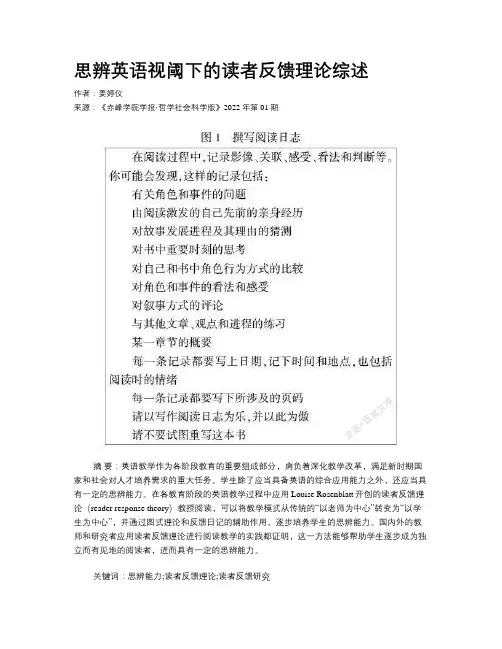
思辨英语视阈下的读者反馈理论综述作者:姜婷仪来源:《赤峰学院学报·哲学社会科学版》2022年第01期摘要:英语教学作为各阶段教育的重要组成部分,肩负着深化教学改革,满足新时期国家和社会对人才培养需求的重大任务。
学生除了应当具备英语的综合应用能力之外,还应当具有一定的思辨能力。
在各教育阶段的英语教学过程中应用Louise Rosenblatt开创的读者反馈理论(reader response theory)教授阅读,可以将教学模式从传统的“以老师为中心”转变为“以学生为中心”,并通过图式理论和反馈日记的辅助作用,逐步培养学生的思辨能力。
国内外的教师和研究者应用读者反馈理论进行阅读教学的实践都证明,这一方法能够帮助学生逐步成为独立而有见地的阅读者,进而具有一定的思辨能力。
关键词:思辨能力;读者反馈理论;读者反馈研究中图分类号:H319.3 文献标识码:A 文章编号:1673-2596(2022)01-0084-06一、英语教学现状过去的很多年,我国传统的教育体系使不少英语老师习惯于在阅读课上详细讲解作者和相关历史事件等背景知识,以及生词、语法规则和文章结构等对于学生应试至关重要的内容。
另一方面,受儒家教育的影响,很多孩子从小就形成了固有的思维模式,以规定的结构进行思考和写作,而不敢轻易表达自己的观点。
这种传统的以教师为中心的课堂里,师生间的互动较少,不能很好地激发学生对于文章的开阔的和有创造性的思考[1],学生思维能力的发展有可能会受到极大的牵制,从而阻碍他们成为独立的思考者。
近年来,随着全球化竞争的推进,很多国家都将思辨能力列入了各级教育的培养任务中。
“思辨”一词,最早语出《礼记·中庸》:“博学之,审问之,慎思之,明辨之,笃行之”。
“慎思”与“明辨”强调周密的思考和明晰的分辨,即基于对信息的分析,而并非信息的简单叠加。
培养思辨能力,就要求我们通过对事物或问题的分析、推理、评估,最终解决问题,或形成决策和结论。
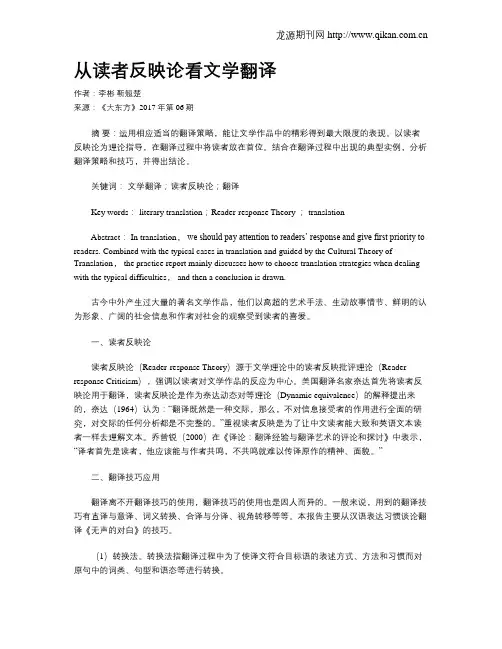
从读者反映论看文学翻译作者:李彬靳翘楚来源:《大东方》2017年第06期摘要:运用相应适当的翻译策略,能让文学作品中的精彩得到最大限度的表现。
以读者反映论为理论指导,在翻译过程中将读者放在首位。
结合在翻译过程中出现的典型实例,分析翻译策略和技巧,并得出结论。
关键词:文学翻译;读者反映论;翻译Key words: literary translation;Reader-response Theory ; translationAbstract: In translation,we should pay attention to readers’ response and give first priority to readers. Combined with the typical cases in translation and guided by the Cultural Theory of Translation, the practice report mainly discusses how to choose translation strategies when dealing with the typical difficulties, and then a conclusion is drawn.古今中外产生过大量的著名文学作品,他们以高超的艺术手法、生动故事情节、鲜明的认为形象、广阔的社会信息和作者对社会的观察受到读者的喜爱。
一、读者反映论读者反映论(Reader-response Theory)源于文学理论中的读者反映批评理论(Reader-response Criticism),强调以读者对文学作品的反应为中心。
美国翻译名家奈达首先将读者反映论用于翻译,读者反映论是作为奈达动态对等理论(Dynamic equivalence)的解释提出来的,奈达(1964)认为:“翻译既然是一种交际,那么,不对信息接受者的作用进行全面的研究,对交际的任何分析都是不完整的。
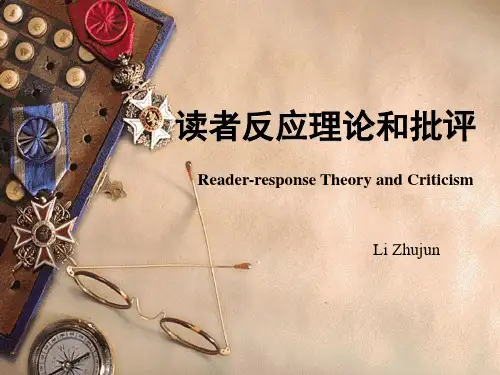
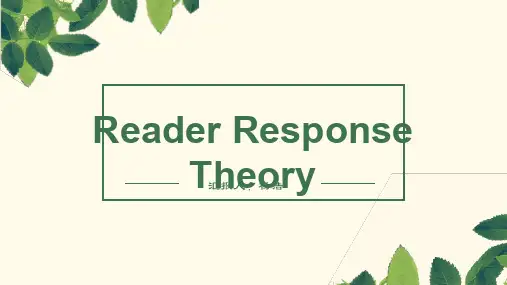
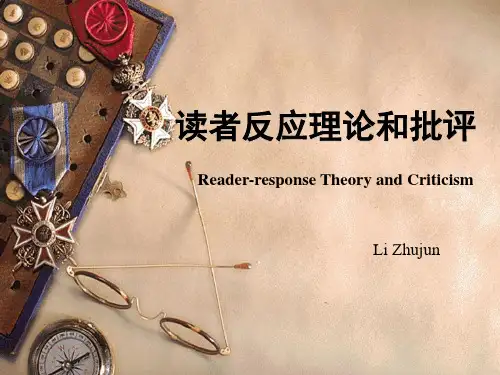
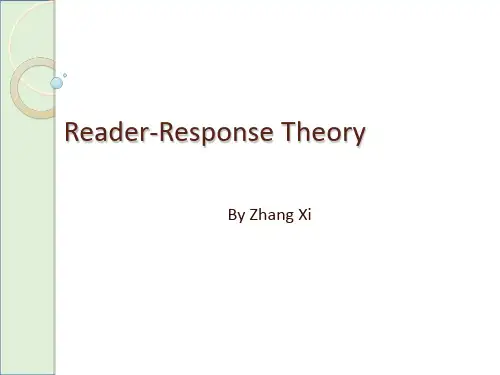
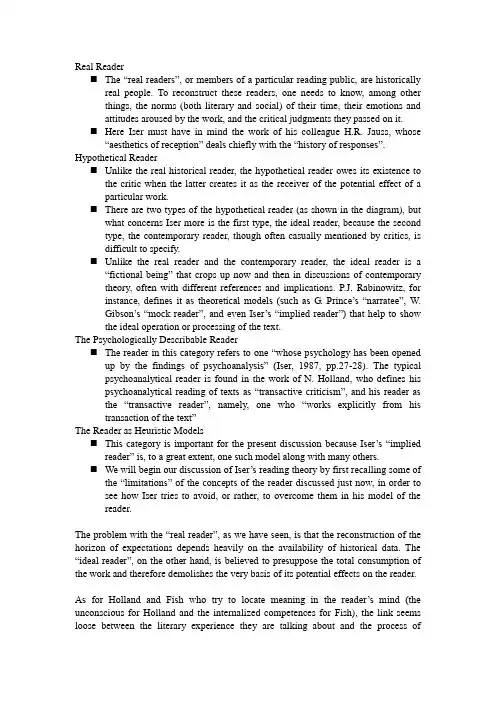
Real Reader⏹The “real readers”, or members of a particular reading public, are historicallyreal people. To reconstruct these readers, one needs to know, among other things, the norms (both literary and social) of their time, their emotions and attitudes aroused by the work, and the critical judgments they passed on it.⏹Here Iser must have in mind the work of his colleague H.R. Jauss, whose“aesthetics of reception” deals chiefly with the “history of responses”. Hypothetical Reader⏹Unlike the real historical reader, the hypothetical reader owes its existence tothe critic when the latter creates it as the receiver of the potential effect of a particular work.⏹There are two types of the hypothetical reader (as shown in the diagram), butwhat concerns Iser more is the first type, the ideal reader, because the second type, the contemporary reader, though often casually mentioned by critics, is difficult to specify.⏹Unlike the real reader and the contemporary reader, the ideal reader is a“fictional being” tha t crops up now and then in discussions of contemporary theory, often with different references and implications. P.J. Rabinowitz, for instance, defines it as theoretical models (such as G. Prince‟s “narratee”, W.Gibson‟s “mock reader”, and even Iser‟s “implied reader”) that help to show the ideal operation or processing of the text.The Psychologically Describable Reader⏹The reader in this category refers to one “whose psychology has been openedup by the findings of psychoanalysis” (Iser, 1987, pp.27-28). The typical psychoanalytical reader is found in the work of N. Holland, who defines his psychoanalytical reading of texts as “transactive criticism”, and his reader as the “transactive reader”, namely, one who “works explicitly from his transaction of th e text”The Reader as Heuristic Models⏹This category is important for the present discussion because Iser‟s “impliedreader” is, to a great extent, one such model along with many others.⏹We will begin our discussion of Iser‟s reading theory by first reca lling some ofthe “limitations” of the concepts of the reader discussed just now, in order to see how Iser tries to avoid, or rather, to overcome them in his model of the reader.The problem with the “real reader”, as we have seen, is that the reconstruc tion of the horizon of expectations depends heavily on the availability of historical data. The “ideal reader”, on the other hand, is believed to presuppose the total consumption of the work and therefore demolishes the very basis of its potential effects on the reader. As for Holland and Fish who try to locate meaning in the reader‟s mind (the unconscious for Holland and the internalized competences for Fish), the link seems loose between the literary experience they are talking about and the process ofcommunication that takes place to shape this very experience.Against these “limitations” Iser‟s concept of the reader stands as a good contrast. He says:⏹If, then, we are to try and understand the effects caused and the responseselicited by literary works, we must allow for the reader‟s presence without in any way predetermining his character or his historical situation. We may call him, for want of a better term, the implied reader. He embodies all those predispositions necessary for a literary work to exercise its effect -- predispositions laid down, not by an empirical outside reality, but by the text itself. Consequently, the implied reader as a concept has his roots firmly planted in the structure of the text; he is a construct and is in no way to be identified with any real reader. (179)The passage quoted above is a concentrated expression of Iser‟s basic ideas concerning the construction of his model and his reactions to the other models. It shows⏹i) the implied reader, as a theoretical construct, could avoid the practicaldifficulties faced by the concept of the “real reader”,⏹ii) though it does not stand for any actual reader, the concept itself implies hispresence and his operation in the process of literary communication,⏹iii) the implied reader carries within itself the “predispositions” that ensure theliterary work both to produce the desired effects on the reader and to elicit relevant responses from him, and⏹iv) what constitutes a major difference between Iser and Holland or Fish isthat the predispositions necessary for the production of effects and responses are determined not by personal desires or competences, but by the very structure of the text itself.Iser‟s concept of the implied reader may be better apprehended through an examination of its structure. From the above brief account it is clear that this structure should be able to account for both the “predispositions” prestructured by the text and the actualizations performed by the reader. For the former, Iser proposes the concept of “the reader‟s role as textual structure”, and for the latter, “the reader‟s role as structured acts”.Each author, in his composition of a fictional work, selects useful materials to create a world of his own inventions, which in on e way or another represents the author‟s view of the real world. But few authors would present their views too explicitly or directly if they want their works to achieve any effect on the reader. Generally, the author‟s view is expressed through the variou s perspectives in the text, which perform two functions, namely, to “outline the author‟s view and also provide access to what the reader is meant to visualize” (180)Thus the textual structure of the implied reader, as we have seen, is composed of or prestructured by three basic components: the textual perspectives, their convergentplace, and the vantage point of the reader. The last two components, i.e., the convergent place of the textual perspectives and the vantage point of the reader, however, only remain potential in the textual structure and have to be actualized by the reader. This actualization is made possible by the other component of the implied reader, i.e., the structured acts.We may take A Dream of Red Mansions for an illustration of the concept of the implied reader. At the beginning of Chapter One, the viewpoints from the narrator‟s perspective tell that the whole story is but the dreams and illusions of the author, therefore the reader‟s vantage point decides that the story is purely f ictional.But this is immediately followed by the statement (another textual viewpoint) that the story is a record of the girls the author has known well, and that the dreams and illusions actually represent the real intention of the novel. So the reader changes his vantage point and believes that the story is real.Then the origin of the story (another textual viewpoint) from the perspective of the Reverend V oid once again puts the reader in an uncertain position as to the credulity of the story, but th is uncertainty is soon cleared up, this time from the stone‟s perspective, when the reader is told that the story is based on true facts without any modification.But this is not all, the reader‟s vantage point may undergo another shift to the contrary when he comes to the Illusory Land of Great V oid (太虚幻境) revealed through the perspective of the plot, especially when he reads the couplet “假作真时真亦假;无为有处有还无” “When false is taken for true, true becomes false; If non-being turns into being, being becomes non-being. ”The perspectives and viewpoints prescribed by the text provide instructions for the reader to build up mental images. The continuous replacement of these images results in shifts of the reader‟s vantage point, reflecting his changing attitudes in the process of reading. Finally, the textual viewpoints and the reader‟s vantage point meet at the convergent place, where the meaning potential of the work is actualized by the reader‟s structured acts.After these shifts of vantage point, most readers would finally agree, as indicated by the author‟s viewpoints, that the pages of the novel are not full of fantastic talks (“满纸荒唐言”), nor would they call the author mad (“都云作者痴”), but that they should read the story carefully and try to understand the au thor‟s message (“解其中味”)This is what we might call the final convergent place of the textual viewpoints and the reader‟s vantage points, or the meaning reached by the reader about the credulity of the story, after his interaction with the text under the guidance of the textual perspectives.From the above description of the implied reader, we may make several general observations about the concept:⏹1) Iser‟s theoretical construct of the implied reader is not an actual reader, noris it an abstraction of it. For any concept of the reader which centers chiefly on the reader to the neglect of other elements in the process of reading is unlikely to give an account of literary communication.⏹2) The implied reader is thus best understood as a phenomenological constructof the actual reader with two roles both as textual structure and as structured acts. These two roles are interrelated and interdependent in that the textual structure provides framework of perspectives for the structured acts to work within, while the latter implements the former to determine a vantage point and to arrive at the convergent place.Y et, the two roles are also in a sense separate, because only a separation allows of the possibility of a relationship between them and makes possible their mutual interaction and final combination in the concept of the implied reader. Just as the idea of the literary work is the result of the interaction between the text and the reader, the two are “separate” though by no means “autonomous” objects.T. Eagleton, believes that “Iser is aware of the social dimension of reading, but chooses to concentrate largely on its …aesthetic‟ aspects”, therefore his reader does not have a foothold in history (Eagleton, 1985, p.83).S.R. Suleiman has made a similar observation when she says that Iser‟s reader “is not a specific, historically situated individual but a transhistorical mind whose activities are ... everywhere the same”. She gives credit to Iser‟s effort at introducing a historical dimension to the description of the reading process by the use of the repertoire, but complains that his readers are still “implied”, not actual (Suleiman in Suleiman & Crosman, 1980, pp.25-26).Iser tries to keep in his phenomenological reader both its virtual presence in terms of “textual repertoire” or “structured acts” and brackets its historical presence. This treatment of the historicity of the reader in a way resembles the textualization of history and the idea of “praxis” (i.e., theoretical but not social practice) fa vored by the post-structuralists (cf. Zhu Gang. 2001, pp.173-175).Other Heuristic Models of the Reader: H.R. Jauss: The Historical ReaderJauss has devised a particular reader, labeled by Jauss himself as “the historical reader”:⏹The role of this historical reader should presuppose that one is experienced inone‟s associations with lyrics, but that one can initially suspend one‟s literary historical or linguistic competence, and put in its place the capacity occasionally to wonder during the course of the reading, and to express this wonder in the form of questions. (Jauss, 1989, p.144)⏹First, this historical reader is one who deals with the effect of a literary workand the reader‟s response to it, and helps to reveal the nature of literary reading as an eventful and process-like experience in more or less the same way as Iser‟s implied reader shows. But the historical reader only wonders during the course of reading. Though this is a clear indication of the reader playing a role and responding to the effects of the text, it does not, in fact, say much about the intricate relationship between the reader and the text.Secondly, contrary to the ideal reader who is free to use his perfect historical knowledge and literary competence, the historical reader suspends both of these in order to have “the capacity occasionally to wonder”. This is understandable, for a reader with perfect knowledge and competence would only provide answers, rather than pose questions to bring about an aesthetic experience.Stanley Fish is perhaps the best known and most polemic American reader-response critic of all . Many of his early ideas (the dramatic nature of reading, the temporal unfolding of meaning, the active role played by the reader in the reading process, etc.) come closest to those of Iser‟s, yet one great difference between them, among others, is reflected in the concept of the role of the reader in their respective heuristic models.For Fish, this reader is someone who projects, expects and corrects his responses all the way as he moves from one word to the next in his linear processing of a text. In formulating his theory of reading, Fish draws on the theory of Chomskian transformational-generative grammar.Fish builds up his model of the reader, which he calls the “informed reader”, characterized by three notable competences: i) competence in the language of the text; ii) semantic competence; and iii) literary competence. The combination of these three competences, as Fish assures us, would unfailingly make any actual reader an “informed” one, and enable him to realize the potential and probable responses a text might elicit. The “informed reader”, therefore, is an abstraction of the idealized actual reader.Iser has observed in his critique of Fish‟s theory t hat the informed reader must “observe his own reactions during the process of actualization, in order to control them” (Iser, 1987, p.32). What Iser is saying here is that Fish‟s reader himself functions as a controlling element in the reading process, as the responses are regulated and organized by the three competences internalized in the informed reader and thus preexist the actual processing of the text.This difference about the controlling element in reading is ultimately again an epistemological question. Here it is enough to point out that such a difference already anticipates the Iser-Fish debate that took place a few years later, and that with the controlling power invested entirely in the reader, the Iserian process of dyadic二元的interaction between the reader and the text necessarily becomes non-existent. Holland maintains that a person reveals his unique personality in the various things hedoes and the various ideas he expresses. Behind these “behavioral transformations”, however, lies an “invariant”, the “unchanging core of personality”, which he calls the “primary identity”, or “identity theme”, a term he borrowed from the modern psychologist Heinz Lichtenstein, and upon which he builds his theory of transactive criticism.For Holland, literary interpretation is inseparable from the question of identity. It is in fact a function of identity, for differences in interpretation can be accounted for in terms of the differences in personality, both being “variations upon an identity theme” (Holland in Tompkins, 1984, p.123). But what is more important is Holland‟s discovery that the “overarching principle” of the function of identity is that “identity re-creates itself.”That is to say, the reader, while reading, makes use of the text to replicate his own characteristic patterns of desires, anxieties, expectations, etc.. This, as Holland seems to argue, is the purpose of reading a literary work, and it is also what his “transactive reader” actually does in the act of reading.In the reading process in which identity recreation is carried out, what the transactive reader does is to find in the text the match for his expectations (e.g., similar wishes and fears), and then to respond by defending against them with his characteristic strategies, either to gratify the wishes, or to defeat the fears.Once the deep wishes and fears are defensively adapted, the reader will be able to derive from the text “fantasies of the particular kind that yield him pleasure” and, therefore, begin to enjoy the text by transforming the guilt and anxiety aroused by the fantasies into “a total experience of aesthetic, moral, intellectual or social coherence and significance.”The brief description given above concerning the recreation of identity through what Holland calls the DEFT (defence-expectation-fantasy-transformation) mechanism serves to show that the “transactive reader” is neither the real reader nor the ideal reader, but an abstraction of any actual reader who reads psychoanalytically, or rather, who is read psychoanalytically by the text he is reading.The concept of the transactive reader has undoubtedly extended our investigation of the reader into the deeper realms of his unconscious, but as a key element in a theory of reading, it is inadequate for a satisfactory explanation of the complex process of literary reading. To use Culler‟s words, Holland “fails to study reading as a process with its own operations and goals” (Culler in Suleiman & Crosman, 1980, p.55).J. Culler: The Ideal ReaderM. Riffaterre: The SuperreaderG. Prince: The Zero-Degree Narratee, and C. Brooke-Rose: The Encoded Reader W. Gibson: The Mock ReaderW.C. Booth: The Reader Created by the Author, or the Implied Reader。
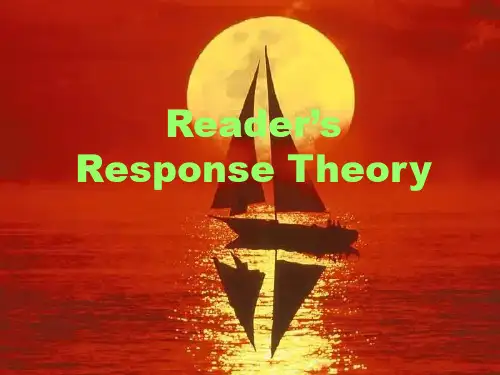
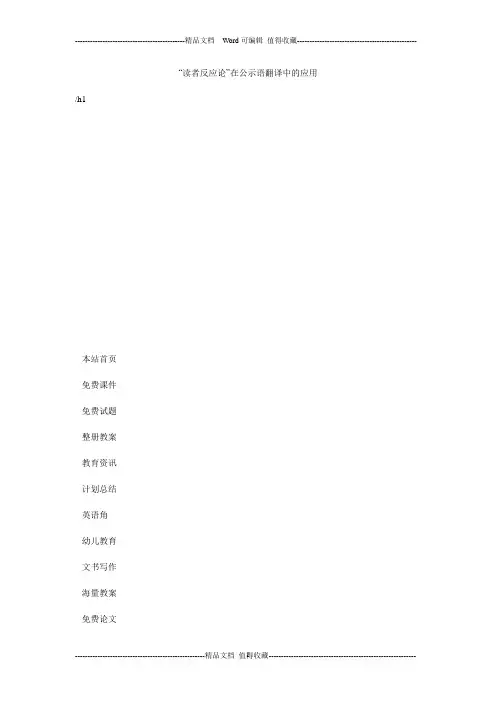
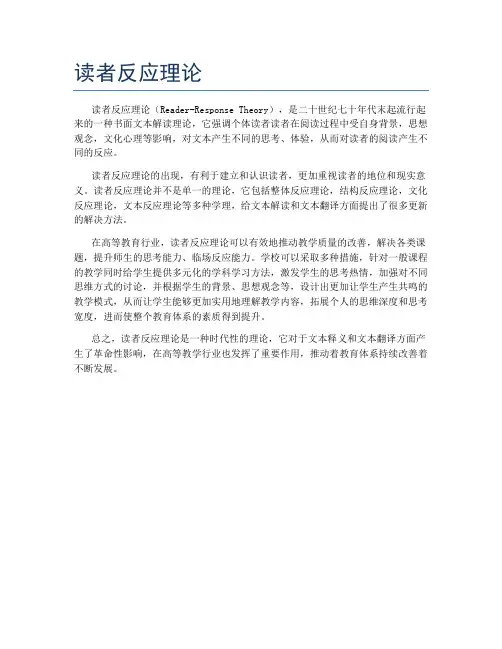
读者反应理论
读者反应理论(Reader-Response Theory),是二十世纪七十年代末起流行起来的一种书面文本解读理论,它强调个体读者读者在阅读过程中受自身背景,思想观念,文化心理等影响,对文本产生不同的思考、体验,从而对读者的阅读产生不同的反应。
读者反应理论的出现,有利于建立和认识读者,更加重视读者的地位和现实意义。
读者反应理论并不是单一的理论,它包括整体反应理论,结构反应理论,文化反应理论,文本反应理论等多种学理,给文本解读和文本翻译方面提出了很多更新的解决方法。
在高等教育行业,读者反应理论可以有效地推动教学质量的改善,解决各类课题,提升师生的思考能力、临场反应能力。
学校可以采取多种措施,针对一般课程的教学同时给学生提供多元化的学科学习方法,激发学生的思考热情,加强对不同思维方式的讨论,并根据学生的背景、思想观念等,设计出更加让学生产生共鸣的教学模式,从而让学生能够更加实用地理解教学内容,拓展个人的思维深度和思考宽度,进而使整个教育体系的素质得到提升。
总之,读者反应理论是一种时代性的理论,它对于文本释义和文本翻译方面产生了革命性影响,在高等教学行业也发挥了重要作用,推动着教育体系持续改善着不断发展。
伊瑟尔读者反应理论【内容提要】伊瑟尔后期转向了文学人类学研究,认为自我的呈现与超越是人的基本需要,而文学虚构正是人类呈现并超越自身的一种方式,这是文学何以存在、人类何以需要阅读文学的深刻根源。
伊瑟尔的文学虚构理论提出了一系列独创性的概念,如越界、表演与文本游戏等,包含着与重视文学对经验现实的再现关系的模仿论以及看重语言能指与所指分离的结构主义、后结构主义文论的批判性对话关系,也是伊瑟尔补足并打破他既往的拒绝接受美学研究,在后现代语境下对文学的性质与功能所作的一个富于鼓舞意义的思索。
虽然人们一般都将文学视为一种虚构,但对何为虚构,它包含哪些要素或步骤,又具有什么样的功能,却众说纷纭,莫衷一是。
大致说来,西方对文学虚构的探讨有两种类型:一是模仿论的观点。
它按照文学与经验现实的关系去认知文学虚构,文学被指出就是对现实的一种恶搞。
这样一来,虚构问题被放在一种认识论的框架中,文学做为虚构与生活或历史形成投影,虚构话语正视某种现实,文学就是对现实的置换,是一种反观各种社会组织和社会关系的手段。
模仿论源远流长,影响深远。
持这种观点的人,从古希腊的德谟克利特、亚里士多德,到近代的车尔尼雪夫斯基,以及当代的卢卡契、奥尔巴赫等,延绵不绝;二就是语言论的观点,它基本上就是20世纪初蓬勃发展的结构主义语言学及语言哲学在文学虚构研究中的应用领域。
这种观点将虚构视作文学语言的一种特定的抒发效果,一种语言的能指与所指之间的偏离现象,代表性见解有理查兹(i.a.richards)的“伪陈述”(pseudo-statement)① 、塞尔(j.searle)的“寄生性”(parasitic discourse)话语② 等。
到后结构主义那里,文学虚构的范围被无穷予以不断扩大,沦为与社会历史毫无关系的语言能指的民主自由游戏,“人们已不仅仅把文学中的事件当做虚构,这些事件在获得定义时所表达出来的‘意旨’或‘对世界的观点’,也被当做虚构。